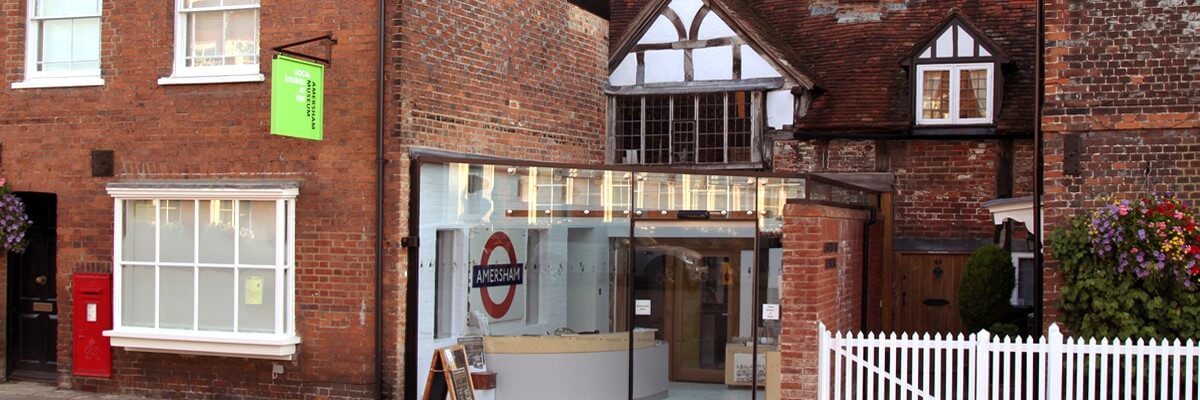Life in Amersham-on-the-Hill
This was written by Mrs P Edwards and is reproduced here with her permission. Another article has been written by her about her memories of Town Farm in Amersham High Street
Our family first moved to Amersham November 1928. I used to walk to see the pigs have their tea on the farm at Hendon, close by the aerodrome. It became so built up the farmer moved and we came out to the country. Mother suffered with asthma, it was hoped the change of air would help her. I clearly remember the exciting day we moved. Much packing and running around. Pillows are awkward things to pack so they were set on the back seat – with me as a 3 year old put on top. Cars were much higher then, more like square boxes. The family spaniel was put beside me and when we went round corners a bit fast I hung on to his collar for balance. No one thought of children’s seats and tying them in. If they fell over it would teach them to be more careful in the future.
After a long time we reached Amersham and Chesham Bois. We drove up Bois Avenue to ‘Ewelme’, later I believe to be called ‘Long Ridge’. It was the one with a double garage beside it with the chauffeur’s flat above. We lived there for 3 years while Father looked round for a plot to buy and build his own house. This was in Hervines Road.
When Father’s parents came from Hendon for the day they really felt they were going into the wilds. The staff would put up a picnic for them and the chauffeur would drive out, carefully timing himself so that he could set off for home at the right time. It was an occasion to talk over for several days after.
The next spring my sister was born. We have a big old fashioned pram with tiny wheels. A baby could lie in it or, when older, sit up and put its shoe-clad feet in the well. If we had a long walk I would be tired and offered a ride home in the handle end of the pram with my feet in the well.
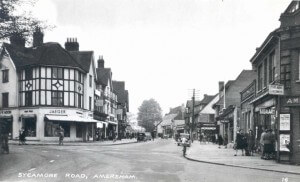
The Bucks Library had the corner big shop at Oakfield Corner, which later became the Post Office [before that Kerridges, now The Entertainer]. It sold newspapers, magazines and sweets and upstairs there was a department for china, glassware and all types of gifts. Then came Barclays Bank where we had an account. When we went in I would be sat on the high counter and allowed to play with the rubber stamps on scrap paper. Mother would have earnest conversations with the teller. His daughter, Zoe was in the same form as me at school.
I would be taken to school on a seat on the back of Mother’s bicycle. This was at ‘Meadows’ run by the sisters, Miss Lillian and Miss Hilda Goldsack. These days it is known as ‘Guido’s’. We wore blue blazers and panama hats in summer with blue berets in winter. One day in the early 1930’s we were coming along the road we smelt a very acrid smell and discovered the whole common was ablaze. We stood on the Heatherton House side of the road for some time, watching. Mr Plummer, the greengrocer, was Captain of the Fire Brigade and he called all his troops out. They were very impressive with their shiny brass helmets on. There was much shouting and running around. The water came from the pond which was bigger and deeper then. After a time we left them to it and went home. At that time the Common was more heath like, open scrub with hardly any trees. For a long time after when passing all one could see was blackened gorse bushes. This must have been 1932 or 33. By December 1933 we had moved into our newly built house in Hervines road, and our brother was born just a couple of weeks later on 14 December 1933.
I was allowed to cycle to school every day on the roads. How different it was then. Few people had cars, traffic was light, and people often left doors and windows open. If I had walked from Hervines I would hope to catch the milkman. He was a kind man and let me have the thrill of a ride home standing in his high cart. When he went into the houses I felt, aged 7 or 8, that I was in charge of the horse. I never wondered how he managed on the days I was not here!
When George V had his Silver jubilee in 1935, Heatherton House put on a display. It was the first time I had seen dancing round the maypole. They must have practised it as it all went off beautifully. Then the tree was planted and we all cheered. I took my dog to have a look at it the other day. How it has grown!
The daily walk was always lightened if we saw the Rector, Mr Lawrence, out visiting with his donkey and trap. He had two donkeys called Rosie and Bud. They lived in the field behind the old Rectory. I believe the modem Rectory has now been built in it. We used to go and swing on the 5 bar gate. The donkeys would come over to us, ever hopeful and sometimes we had an apple or carrot for them. It was always time to go before I had finished talking to them.
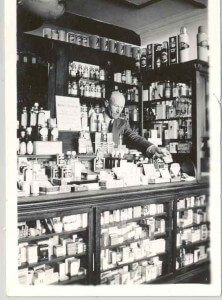
After Barclays Bank walking along Sycamore Road, there was a gap big enough for a car to drive down. Mr Dixon, the vet from Berkhamsted, came every Wednesday. He held a clinic behind Kennards the chemist. He was a very tall man with kind eyes. He must have been nearly 6’5″. He always sat bent in his car to fit in. If our pet was really ill it would be taken by car to his house in Berkhamsted High Street. It was one of a terrace with a large arch at the side. As children we asked what the arch was for. Instead of saying to give car access, etc to the land and stables at the back, he opened his twinkly eyes wide and said it was so the elephants could go in to have their toenails cut! Kennards is now called Temptations, then there was another bank and a hat shop for superior ladies, Jane Evans. No one ever seemed to go in or out but she was there for years. Shortly after there was the road to Woodside Close to cross.
The first shop the other side was Napiers, that became Woodcocks (see photos below), then Accent and is now a phone shop. It seemed there had always been a dress shop and haberdashers there. As one went in the porch on the left there was a big mirror-faced door. People did not always see that it was a door. On one morning a week several of us children from families round about would be taken through and up the stairs that led to the room overlooking Sycamore Road. Here we were taught percussion, very, very earnestly.

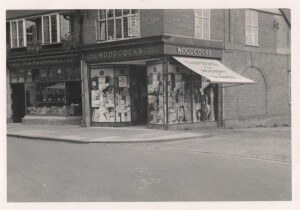
Once a year the tortoise man would come. He would stand in the gutter outside Barclays Bank and put his cargo down in the road while he gave his ‘spiel’. There was so little traffic the animals were quite safe. Occasionally, one would go a bit far off and he would fetch it but not often. Most people shopped with a basket then so if someone wanted a tortoise it was picked up and put in the basket to go home on top of anything else bought that day. I believe the war stopped him coming, like the French onion sellers on their bicycles with strings of onions tied to their cycles and sometimes round their necks as well.
Further along we came to Plummers, the greengrocers, and then John 18, the wet fish shop. As was the fashion he had a sloping marble counter with water trickling down to keep the goods fresh. Very pretty arrangements were made with the dead fish artistically laid out. At the bottom there would be a row of ducks, hens, etc, always with their heads hanging over the edge towards the pavement. Bills were entered in a book and sent up to the house monthly to be paid. John 18’s book cover was blue and Mother had passed into the open shop and was talking to the woman in the glass covered cubicle discussing the book. Our old spaniel, who never needed a lead, had followed Mother from home, waited on the pavement. He eyed the birds and eventually they got the better of him. He grabbed a neck, tossed the body over his shoulder and was off down the road at a rate of knots! The woman at the desk did not bat an eye “that will be another (Xs Xd) on the bill Mrs McKenzie”. There was Mother hoping no one had seen!

The next shop was a wooden log cabin type called Woods. They sold cigarettes, matches, newspapers, etc and they had a board in the shop for “Wanted and Selling” that was always of much interest. Then there was Hall’s Market Garden. The earth pavement here was quite high from the road with several big trees growing on the road bank. One had to step down to go into Hall’s greenhouse. He sold things like lettuces, marrows, tomatoes, etc. He cultivated the land either side of his greenhouse.

St Michaels came next with a good sized village hall used by all institutes, clubs and associations. This was followed by the cobbler or shoe mender. His room was always dark, with one very dirty window. There was always a gas pit burning for his work. I have forgotten his name. He was a very big man in an apron, with no hair on his head at all. To my horror he usually had a mouth full of tacks but he never seemed to swallow any. A double hairdresser finished that side of the road, men first and ladies on the corner.
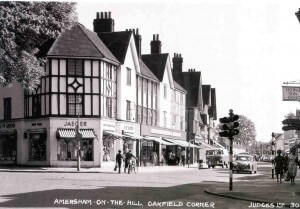
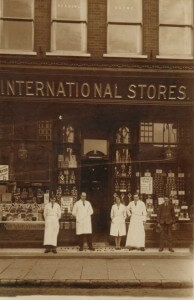
At Oakfield Corner there were not so many shops on the north side of the road. We started off with the International first, the greengrocer and next to it the double fronted grocers. There was always a smell of cabbage and cauliflower leaves from the first followed by bacon and coffee from the next. Of course they had chairs to sit on at the counters for ladies while they gave in their order – all to be delivered, often the same day. Then there was the alleyway, closely followed by East’s Wool shop with every colour, every thickness of wool. Everyone needed to knit then as it was so much cheaper than buying clothes. After East’s came Stowell’s, the wine merchant. They also delivered and many houses had standing orders. People would drink at home then, or invite friends in for a meal and a drink. It was very unlikely for men to go to a pub, unless it was recognised as a working men’s pub. It was quite unheard of for a lady to go in a pub.
The shops stopped after that. The rest of that side of the road was taken up by big houses with front gardens which came down to the pavement and road. All of them had large sycamore trees that gave the road its name. From Oakfield Corner going up the Chesham road there was a tea shop of the sort never seen now. Waitresses would give you a set tea of assorted sandwiches, individual cakes and probably some slices of fruit cake, all on a stand. Unless you had a real preference and asked for something individual like toasted teacakes (hot with melting butter). It was also possible to drop in during the morning, but to say “let’s go to …… for tea” was really a treat. Nice china, home-make cakes and all beautifully presented was enticing.
Then came Mr Berkley, the butcher. He was a kind, big man who did not enjoy very good health. If nothing much was happening at home in Bois Avenue, Brownie, our spaniel, would take himself down to Berkley’s. It did not matter if there was a queue or not. He would stand in the door and chortle or snort looking straight at Mr B. “Hello Brownie, have you come for a bone? Mr B would find a good sized bone and lean over the counter to Brownie who took it graciously with another snort as he went out of the shop, much to the amusement of all there. He probably had to put it down several times on the way back if it was a big one or sit in the road and have a good scratch – cars were so few then. Berkley’s book was also a blue hard cover, with his name in gold with an ox head underneath. When Father looked at the back at the end of the month there would be “Bones to Brownie £x xs xd”. Father never queried and always paid up. He said Brownie was worth his bit of luxury.
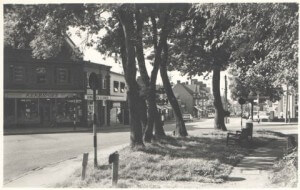
Going down Station Road there was Howard, Son & Gooch, Estate Agents, a jeweller and Kitty (Kathleen) Graham, tea shop and baker, and a bicycle shop which was very good. It was possible to buy anything to do with bicycles there. Kingham’s the grocer was run most efficiently by Mr Grisswood. He was never seen without his white gown which was buttoned on to his waistcoat and reached his shoes, always immaculate. His monthly book was red. His man would drive up to our house on a Wednesday and sit with our cook – having coffee or tea with a slice of home-made plum cake – putting her order in. He would realise it was nearly time to go and ask if she had tried ‘x’ for cleaning or she really must not run short of ‘y’. “Thank you I have just time for another cup etc, etc!” Thursday was always delivery day. It was also Cook’s day off and so the door would be opened “thank you” and shut, not such a good day for him.
Nancarrow, bespoke tailor, was the last building between Kingham’s and a field. Where the Royal Mail Sorting Office now stands was a field with two horses. Children used to love them.
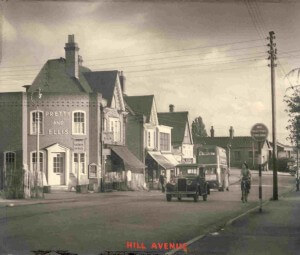

Over by Elm Close, there was Swannell and Sly. Pretty and Ellis moved later from the opposite side of Station Road. We then came to Slade’s Dairy where two very large storks in china filled the window. All the proper dairy produce from their Chesham Bois farm was on sale. After that was Pope’s corn and seed merchant (dog biscuits, animal feed, etc.) That was closely followed by Mr Cosby who ran Heavens, stationer, toy shop, tobacconist, and so on which was great for spending weekend pocket money.

This brought one up to Station Garages. Many people had a love/hate relationship with them. They were the only people of that size around. There was one delightful, never-to-be-forgotten day when before the War wives would drive their men to the station or the men drove and as they got out the wives slid across to drive home. It was a summer morning. The husband got out and ran for his train. She moved over ……. the car would not start! She tried very hard and then hooted her horn for someone to come out from the garage. They were either busy or did not realise it was meant for them. The train had now long gone. So, at last, in despair she had to get out and walk the few yards to the garage. Unfortunately, it became very apparent she had come straight from bed and was only wearing a see-through nightdress. She got excellent attention from the garage hands.
Just on the road below the platform Mrs Gibbs ran her sweet stall in the little wooden shed. It was wonderful in there. Before the War she would sell from barley sugar horses or fishes to liquorice bootlaces, sherbet dabs or aniseed balls (eight for one penny).
Mr Upton was the local postman. Poor fellow, he had the biggest feet in Amersham. During the war he was my father’s Home Guard Sergeant. They had to have boots specially made for him. My brother was at boarding school and he wrote to my sister and, feeling flippant, he put on the outside “Sorry about the mess on the envelope – the postman did it”. Poor old Upton was very upset. He rang our bell and insisted on speaking to Father – swearing he had not done anything to the letter, etc. etc. It took a lot from Father to calm him down saying he was sure, etc, etc, boys would be boys and he would speak to him. Upton went away still muttering “I didn’t do it. I didn’t”.
Also during 1939-40 it was thought to be a good idea to put a 1914-18 cannon at the top of Devonshire Avenue, looking straight down the avenue. It is very doubtful if any ammunition was available to fire it after Dunkirk. Of course Hervines “Park” had a line of trees as if continuing from Devonshire Avenue. It continued the building line. Houses were expected to fill the park but the War put a stop to that. At some time the council bought the land from the Drakes and decided a park would be good for Amersham. During the War, cut down trees were used to stop German parachutists landing as they had in so many countries on the continent. The row of planted trees must have been pulled up after the War at the same time as the ‘pit props’. The Grammar School has been glad of the extra land ever since. Now with the Bowling Green and Council Plant Garage & Workshop it all looks very different from the simple field we used to play in and take the family dogs for an early morning run.
The wood was bigger then. It was possible to walk on a path with the woods on the left with the garden of the big Copperkins houses on the right until one came to the last houses of Weedon Lane. Most of those big houses had a horse in the lower part of their land and still leave a garden big enough to employ a gardener. The footpath carried on to the Rugger Club. None of all those new roads and houses came till after the war. Taxes became so high to pay for the war that few people could live in the big three storey houses. The top floor was for Nanny and children, with food sent up on a dumb waiter until the little dears had learnt table manners and not to talk if the grown¬ups were speaking, etc. Several of these sons became just old enough to join up in the six years of the War. The answer in many cases was to pull the houses down at the same time, making enough room to put roads and small houses in their place.
Opposite the Boot & Slipper on that corner there was a little shop. It was entered from the Chesham Road. As one stepped down into it the spring bell gave a sharp Victorian ‘ping’ which brought Mrs Wells out from the back, usually wiping her hands. From what was her front room she would sell all kinds of newspapers and goods. Making a large wooden lean-to at the side was Mr Wells root and veg stall. All was locally grown and he had his scales there and when he was not serving he was off round the district doing his paper delivery on his bicycle. ‘Mother’ would then stand in for him if necessary.
Where the NatWest Bank stands was also a field for horses well into 1950’s. All through that time I ran my dogs on the field that is now the Law Courts, Council Offices and Police Station.
How many others remember Brentnall & Cleland coal depot in the station ground. They had accommodation for horses, donkeys and cattle there too, years ago. There were cattle pens to temporarily hold them in. What happened to them later I do not know.
Along Copperkins Lane, adjoining Heatherton House land, one old man lived in a wooden cabin on wheels. He kept his land beautifully, growing all his own vegetables, etc. Unfortunately, he only had one leg. The other finished above the knee with a straight iron ‘post’. This meant he could walk, with a limp, but his real means of getting around was his bicycle. Someone had adapted it for him so that the pedal only went round on his good leg. The other pedal stayed near the ground so he could rest the round end of his iron leg on it. He was a well-known sight pedalling round the district. The far end of Copperkins Lane there was a brick yard on the left. Opposite the old road curved for a few yards and then came back and joined Copperkins Lane proper. In this area a band of gypsies lived for many years. It was always understood they gave the name to the road, ie copper skins. The Lane had some very fine big houses built in late Victorian or Edwardian times. Mr Ellis of Pretty & Ellis lived along here. A very charming old gentleman who always had his stick with him and would raise his hat with a real flourish when he said “Good morning”. He made a habit of always buying a flag if he met a seller as he said he had met his wife when she was selling flags and she had given him so many happy years.
During the War the Home Guard were exercising one Sunday. It was decided if they built a trench opposite Bois Avenue they would have command of opposition in the Avenue as well as up and down Copperkins Lane. They set to digging with gusto. The trench got lower. Suddenly, there was an almighty “BANG”. They had gone through the main electricity cable = no cooked Sunday lunch for a considerable part of Chesham Bois.
There was an early morning post and sometimes a second, especially around Christmas when the load would be heavy. An afternoon post was looked for if we had London visitors staying. At school I was made to learn 1 1/2 times table so I would know that 8 stamps could be bought for 1 shilling. [Editor’s note for younger readers, there were 12 pennies in a shilling and 20 shillings in a pound before decimalisation in 1971.] Post cards and open envelopes went with a second class green stamp. First Class was a sealed envelope with a red I 1/2d stamp. It was quite accepted to post to a friend by breakfast saying you would need to be met at the station that evening, or even if it was posted before 9am to tell friends you were unable to come to that day. Unbelievable in modem times of so called progress. Doors were left unlocked, indeed often open. Windows could safely be left open day and night. Children could go out and play in the fields, only returning when they were hungry or it was getting dark. The War made a great change to everyone’s lives.

